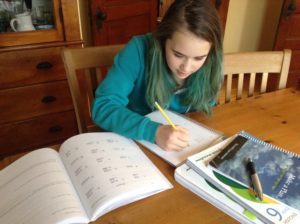 One of the most valuable benefits of homeschooling is flexibility. Flexibility to dive deeply into one topic. Flexibility to develop a passion. Flexibility to travel, to take advantage of unexpected opportunities, and just slow down and enjoy family time. Many families tell us that this flexibility is the reason they able to “live their learning” in a way that just wouldn’t happen if they were enrolled in traditional school.
One of the most valuable benefits of homeschooling is flexibility. Flexibility to dive deeply into one topic. Flexibility to develop a passion. Flexibility to travel, to take advantage of unexpected opportunities, and just slow down and enjoy family time. Many families tell us that this flexibility is the reason they able to “live their learning” in a way that just wouldn’t happen if they were enrolled in traditional school.
Some parents have an instinctively flexible approach to home teaching. Others naturally choose a more structured and measured approach. Neither is inherently better, as long as it is working for you and your child. But no matter who you are, sometimes homeschooling can feel overwhelming, and when that happens, flexibility can come to the rescue.
What do you mean by flexibility?
Some families begin the homeschool year, dutifully follow all instructions just as they are presented in the curriculum, and soon find themselves overwhelmed. They may not realize that Oak Meadow curriculum is designed with the assumption that parents and home teachers will adapt it to fit their family’s needs, picking and choosing from the options offered in each lesson.
As a general rule, it is a good idea to be deliberate and thorough in your approach to home teaching. Resisting the urge to plow ahead quickly in the curriculum will help you and your child establish the habit of a healthy, unhurried pace to learning. But at times, it will be appropriate to speed up or slow down in response to your child’s needs. A student who is struggling or is new to a concept may need more time, more attention, and more practice before being ready to move on.
On the other hand, some learners will grasp concepts more readily than others, and they will be capable of moving onto the next lesson faster and with less repetition than a student who needs more time and practice to understand a given topic. If a given lesson covers something that your child has already encountered, perhaps even mastered, you can choose to review that material quickly, do only selected assignments, or even skip the lesson altogether.
In the lower grades, it is especially important to keep things developmentally appropriate for students even when they are academically advanced. Some younger students may need supplemental material to keep them engaged with the lessons at a developmentally appropriate pace. And of course, if you find that an assignment leads to investigating a compelling tangent, you can take the time to explore it before moving on. If your family gets very excited about something else you’ve encountered—investigating local history, or seasonal science projects that make sense to do right away—you can postpone the next lesson until you are ready.
How will I manage it?
 For those who prefer a measured approach to planning, there is a default structure inherent in Oak Meadow’s curriculum format. Each lesson is designed to be completed in one week. Planner pages are available to help in mapping out what needs to be done and when. There are also other less regimented approaches that can work well. Some families prefer block scheduling, in which students focus on one or two subjects only for multiple lessons before switching to a different subject. For students who find transitions challenging, this approach can help them maintain focus and accomplish more in a shorter time. For some, block scheduling means assigning one subject per day in the course of a week. For others, just one or two subjects might be the theme for a month or longer before moving on.
For those who prefer a measured approach to planning, there is a default structure inherent in Oak Meadow’s curriculum format. Each lesson is designed to be completed in one week. Planner pages are available to help in mapping out what needs to be done and when. There are also other less regimented approaches that can work well. Some families prefer block scheduling, in which students focus on one or two subjects only for multiple lessons before switching to a different subject. For students who find transitions challenging, this approach can help them maintain focus and accomplish more in a shorter time. For some, block scheduling means assigning one subject per day in the course of a week. For others, just one or two subjects might be the theme for a month or longer before moving on.
Others use a loop scheduling approach, where some or all subjects are placed in a loop rather than a weekly schedule. With loop scheduling, you move through the list one item at a time, addressing the next item whenever time allows instead of by the calendar. If one subject needs more frequent attention than the others, you include it twice in your loop. If some unforeseen event means you aren’t able to get anything done for a day or so, you simply pick up where you left off in the loop as soon as you can.
Even the most organized parents sometimes find themselves off track, whether because of a family crisis, an unexpected illness, travel, or a very exciting spontaneous learning opportunity. This is one of the beautiful gifts that homeschooling gives us—the flexibility to allow life to get in the way sometimes without upending the academic year as a whole.
How will we get everything done?
If you are someone who enjoys taking a relaxed approach to when the “curriculum year” starts and ends, you may feel just fine going with the flow and letting all things happen in their own time. If you take summers off, you might pick up where you left off when fall comes around again, or you might just keep going year-round through the years.
But if your goal is to finish all of one grade in a year, particularly if you are obligated to a traditional school schedule with mandatory reporting, you will want to keep an eye on the overall arc of your progress through the curriculum. If you expand in some areas, you may need to find a way to contract in others to complete a year’s worth of material on time.
However you approach the year, be clear about your priorities, and refine your goals throughout the year as you get a better sense of what is realistic to expect from yourself and your child at each stage of development.
How will I know what my child needs?
You are the expert on your own child’s needs, and your instinct will guide you well if you pay attention to it. Children tell us in many ways when they are overwhelmed or confused and need to slow things down; likewise, they have ways of telling us they are done with a lesson and ready to move on.
Plan some buffer time in your days and weeks so that you have room for lessons that take a little longer or lead to unplanned learning opportunities. Make sure everyone, parents included, gets enough down time to balance out focused academic time. Plenty of active play outdoors can help get the wiggles out—at any age—to ensure better focus during lesson time.
If you continue to feel overwhelmed and unsure about how to make the most of flexible planning, or if you want help tailoring specific Oak Meadow lessons to meet your child’s needs, an hour or more of homeschool support consultation with an experienced Oak Meadow teacher can be very helpful.
Enjoy a flexible approach to homeschooling!
Be open to expanding and streamlining your homeschooling plan as needed throughout the year. A flexible approach to homeschooling helps to keep enjoyment high and stress minimal. Flexibility is one of the most helpful tools for happy, healthy homeschooling.